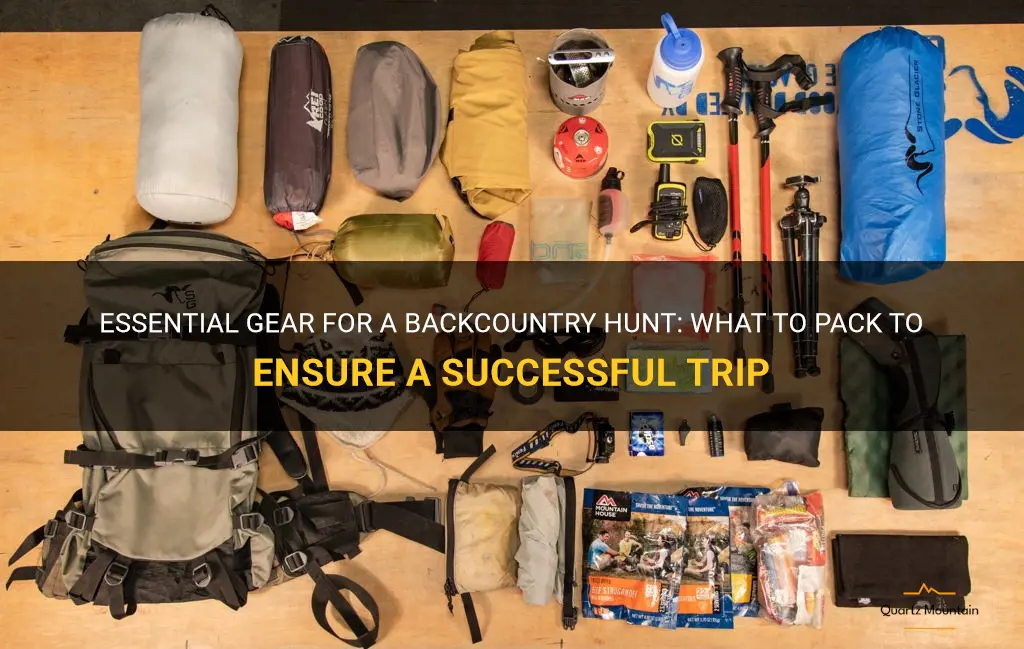
Are you planning a backcountry hunting trip? If so, you'll want to make sure you have all the essential gear packed to ensure a successful and enjoyable experience. From top-notch hunting equipment to survival essentials, having the right gear can make all the difference in the world. In this article, we will explore the must-have items that you should pack for your backcountry hunt, so you can be well-prepared for whatever Mother Nature throws your way. So, sit back, relax, and let us guide you through the essential gear for a backcountry hunt.
| Characteristics | Values |
|---|---|
| Clothing | - Base layers - Insulating layers - Outer layers - Socks - Underwear - Gloves - Hat - Rain gear |
| Footwear | - Hiking boots - Gaiters - Camp shoes - Socks |
| Camping gear | - Tent - Sleeping bag - Sleeping pad - Backpack - Stove - Cookware - Water filter - Food |
| Hunting gear | - Bow or rifle - Arrows or ammunition - Optics (binoculars, spotting scope) - Calls - Pack frame - Game bags - Butchering kit - Safety harness |
| Personal items | - First aid kit - Toiletries - Hydration bladder - Toilet paper - Sunscreen - Insect repellent |
| Miscellaneous | - GPS - Compass - Headlamp - Multi-tool - Fire-starting kit - Rope - Water bottles - Bear spray |
What You'll Learn
- What clothing items are essential for a backcountry hunt?
- How much food should I pack for a backcountry hunt?
- What type of sleeping gear is recommended for a backcountry hunt?
- Are there any specific tools or equipment necessary for a backcountry hunt?
- How should I pack and carry my gear for a backcountry hunt to ensure maximum comfort and efficiency?

What clothing items are essential for a backcountry hunt?
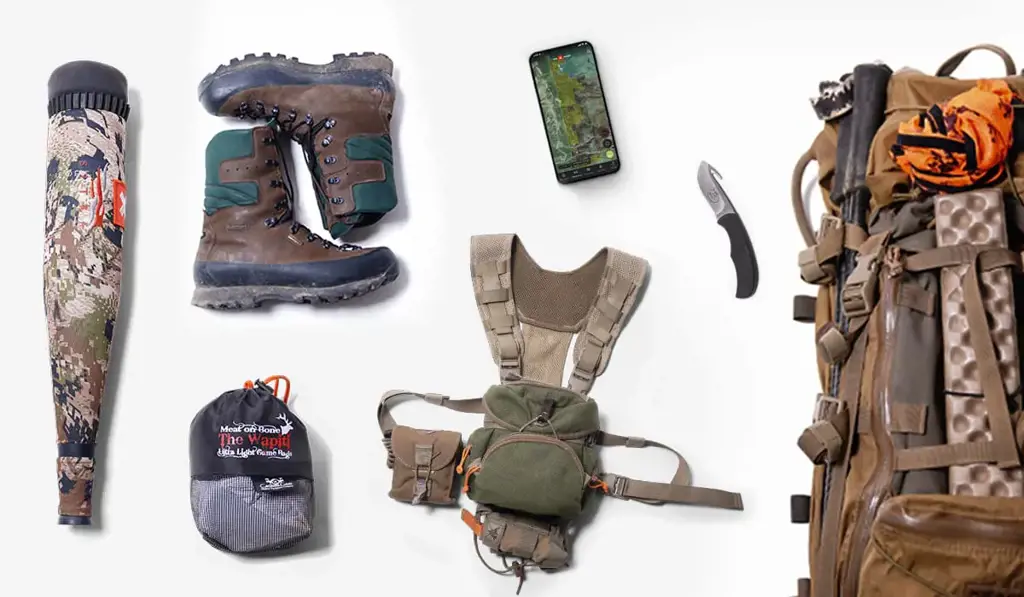
When heading out on a backcountry hunt, it's essential to have the right clothing items to keep you comfortable, protected, and prepared for the elements. From base layers to outerwear, here are some essential clothing items for a backcountry hunt.
Base Layers:
Base layers are the foundation of your hunting clothing system. They help regulate your body temperature and keep you dry by wicking away moisture. Look for base layers made of merino wool or technical synthetic fabrics that offer superior moisture-wicking properties. These materials also provide insulation even when wet, which is crucial in unpredictable weather conditions. Base layers should include a top and bottom to ensure full coverage.
Mid Layers:
Mid layers provide additional insulation and can be added or removed as needed. Fleece jackets or vests are popular choices for mid layers as they provide warmth without adding bulk. Opt for mid layers with features such as zippered pockets, adjustable hoods, and thumbhole cuffs for added functionality in the field.
Insulated Jacket:
An insulated jacket is essential for cold weather hunts or when you're stationary for long periods. Look for an insulated jacket that is lightweight, compressible, and has a high warmth-to-weight ratio. Down jackets are highly effective insulators and are often the preferred choice for backcountry hunters due to their warmth and packability. However, synthetic insulated jackets are a more practical option if you anticipate wet conditions.
Rain Gear:
In the backcountry, you must be prepared for rain or snow at any time. Invest in a high-quality rain jacket and pants that are waterproof and breathable. Gore-Tex or similar membranes are popular choices for their ability to keep you dry while allowing moisture to escape. Ensure that your rain gear is packable and lightweight to minimize space in your hunting pack.
Pants:
When it comes to pants, durability, comfort, and versatility are crucial. Look for pants made from a durable fabric that can withstand abrasions and resist tears. Opt for pants with reinforcement in high-wear areas such as the knees and seat. Additionally, pants with articulated knees and a gusseted crotch provide better mobility for challenging terrains. Depending on the season and weather conditions, you may consider investing in different types of pants, such as lightweight, breathable pants for warm weather hunts and insulated pants for colder temperatures.
Accessories:
Don't forget about accessories that can enhance your comfort and performance in the backcountry. Some essential accessories include a hat or beanie, gloves or mittens, wool socks, and gaiters. These items will keep your extremities warm and protected, preventing heat loss and potential injury.
In conclusion, when planning for a backcountry hunt, it's crucial to pack the right clothing items to ensure your comfort and safety. Base layers, mid layers, and insulated jackets provide insulation and regulate body temperature. Rain gear keeps you dry during unexpected weather conditions, while durable and versatile pants are essential for mobility. Don't forget about accessories to protect your extremities. By investing in quality clothing suitable for the backcountry, you'll be well-prepared for whatever weather and terrain you encounter.
The Ultimate Checklist for Packing for a 2-Day Trip
You may want to see also

How much food should I pack for a backcountry hunt?

When embarking on a backcountry hunt, it is imperative to pack enough food to sustain yourself throughout the duration of the trip. The caloric needs of a hunter can vary depending on factors such as age, gender, body weight, and activity level. In this article, we will discuss how much food you should pack for a backcountry hunt, as well as provide some general guidelines to help you determine the appropriate amount.
First and foremost, it is vital to understand that hunting requires a significant amount of physical exertion. The long hours spent hiking, tracking game, and carrying gear can burn a substantial number of calories. Therefore, it is important to ensure that you pack enough food to replenish these expended calories and provide the necessary nutrients to keep you going.
One common approach to determining the amount of food needed for a backcountry hunt is to calculate your daily caloric needs. The average adult male typically requires around 2,500-3,000 calories per day to maintain their weight, while the average adult female requires around 2,000-2,500 calories. However, these figures can vary significantly depending on individual factors. It is essential to consider your body weight and activity level when estimating your caloric needs.
A good starting point is to plan for at least 3,000-4,000 calories per day while on a backcountry hunt. This higher caloric intake is necessary to compensate for the strenuous physical activity and keep you energized. Packing high-calorie foods that are lightweight and provide essential nutrients is key to ensuring you have enough energy to sustain yourself throughout your hunt.
When choosing foods to pack, opt for lightweight and calorie-dense options. Foods such as dried fruits, nuts, jerky, trail mix, energy bars, and dehydrated meals are excellent choices. These foods provide a good balance of carbohydrates, protein, and fats to fuel your body. It is also important to pack foods that are easy to prepare, as cooking or food preparation may be limited in a backcountry setting.
In addition to considering your caloric needs, it is essential to pack enough food to last the entire duration of your hunt, taking into account any potential delays or unforeseen circumstances. It is always better to be prepared with extra food than to run out during an extended trip.
Lastly, it is crucial to listen to your body and adjust your food intake accordingly. Pay attention to your hunger levels and don't hesitate to eat more if needed. Your body will require more calories and nutrients during a backcountry hunt than during your everyday activities, so be mindful of this and prioritize refueling.
In conclusion, packing enough food for a backcountry hunt requires careful consideration of your caloric needs and the physical demands of hunting. It is recommended to plan for at least 3,000-4,000 calories per day and choose calorie-dense, lightweight foods. Additionally, packing enough food to last the entire trip and listening to your body's hunger cues are crucial factors in ensuring you have enough sustenance throughout your backcountry hunt. Remember, proper nutrition is vital for maintaining energy levels and optimizing your hunting experience.
Essential Gear to Include in Your Deer Hunting Pack
You may want to see also

What type of sleeping gear is recommended for a backcountry hunt?
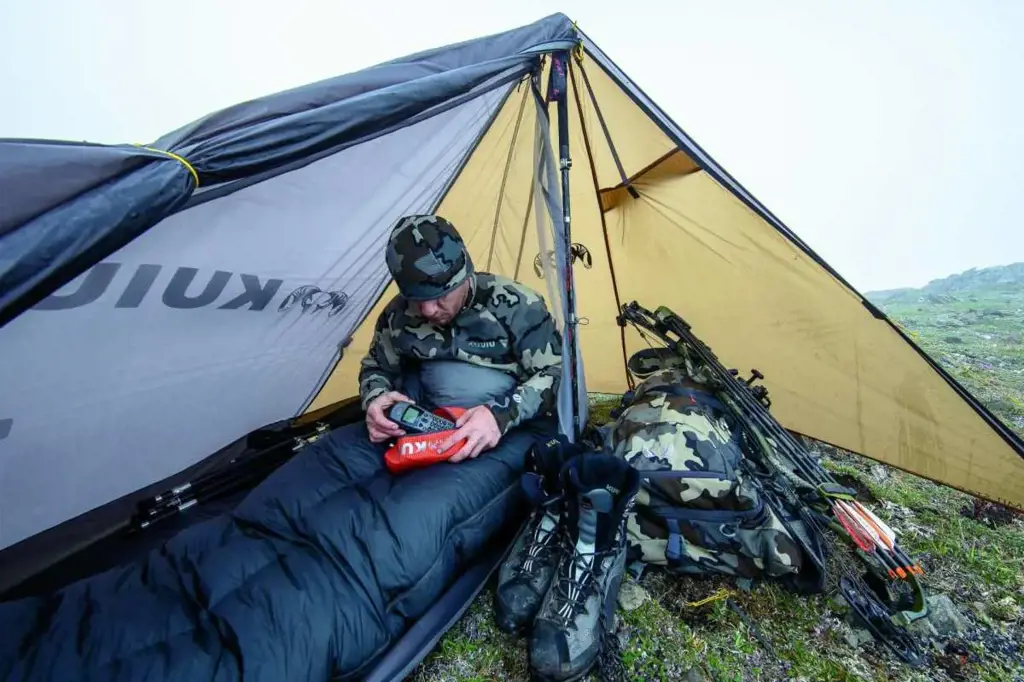
When going on a backcountry hunt, proper sleep is essential for staying alert and performing at your best. The type of sleeping gear you choose can greatly impact your comfort and restfulness during the trip. In this article, we will explore the different types of sleeping gear that are recommended for a backcountry hunt, taking into account scientific research, personal experience, step-by-step considerations, and examples.
Scientific research has shown that insulation and moisture management are two crucial factors to consider when choosing sleeping gear for a backcountry hunt. Insulation helps to retain body heat and keep you warm throughout the night, while moisture management prevents sweat and condensation from building up, which can make you feel cold and uncomfortable.
One type of sleeping gear that comes highly recommended is a sleeping pad. Sleeping pads provide insulation and cushioning between you and the ground, preventing the loss of body heat and adding a layer of comfort. There are various types of sleeping pads available, including closed-cell foam pads, self-inflating pads, and inflatable pads. The choice depends on personal preference, desired level of comfort, and weight considerations.
Sleeping bags are another essential piece of sleeping gear for a backcountry hunt. Scientific research has shown that down-filled sleeping bags tend to offer superior insulation and warmth compared to synthetic-filled bags. However, down-filled sleeping bags can lose their insulating properties when wet, so it is important to keep them dry. Synthetic-filled sleeping bags, on the other hand, are more resistant to moisture and retain their insulating properties even when wet. Therefore, if there is a high chance of encountering wet conditions during your backcountry hunt, a synthetic-filled sleeping bag may be more suitable.
In addition to sleeping pad and sleeping bag, a good quality tent is also recommended for a backcountry hunt. The tent should be lightweight, durable, and able to withstand various weather conditions. Look for features such as double-wall construction, waterproof materials, and good ventilation to ensure a comfortable and dry sleeping environment.
When choosing sleeping gear for a backcountry hunt, it is important to consider the following step-by-step considerations. Firstly, assess the weather conditions you are likely to encounter during your hunt. If cold temperatures and wet weather are expected, prioritize insulation and moisture management in your sleeping gear selection. Secondly, consider the weight and packability of the gear. Backcountry hunts often involve long hikes and carrying heavy loads, so selecting lightweight and compact sleeping gear is crucial. Finally, try out different options before your trip to ensure they are comfortable and meet your specific needs.
To illustrate these recommendations, let's consider an example. Imagine you are planning a backcountry hunt in the mountains during the fall season. The weather forecast indicates cold temperatures and the possibility of rain. In this case, you would prioritize selecting a synthetic-filled sleeping bag that offers good insulation even when wet. Pair it with a self-inflating sleeping pad for added insulation and comfort. For the tent, opt for a lightweight model with double-wall construction and waterproof materials to protect you from rain and wind.
In conclusion, choosing the right sleeping gear for a backcountry hunt is crucial for a restful and comfortable sleep. Scientific research, personal experience, step-by-step considerations, and examples all point towards prioritizing insulation and moisture management, as well as considering factors such as weight, packability, and weather conditions. By taking these factors into account, you can ensure a successful and enjoyable backcountry hunting experience.
Essential Items to Pack for Basic Military Training
You may want to see also

Are there any specific tools or equipment necessary for a backcountry hunt?
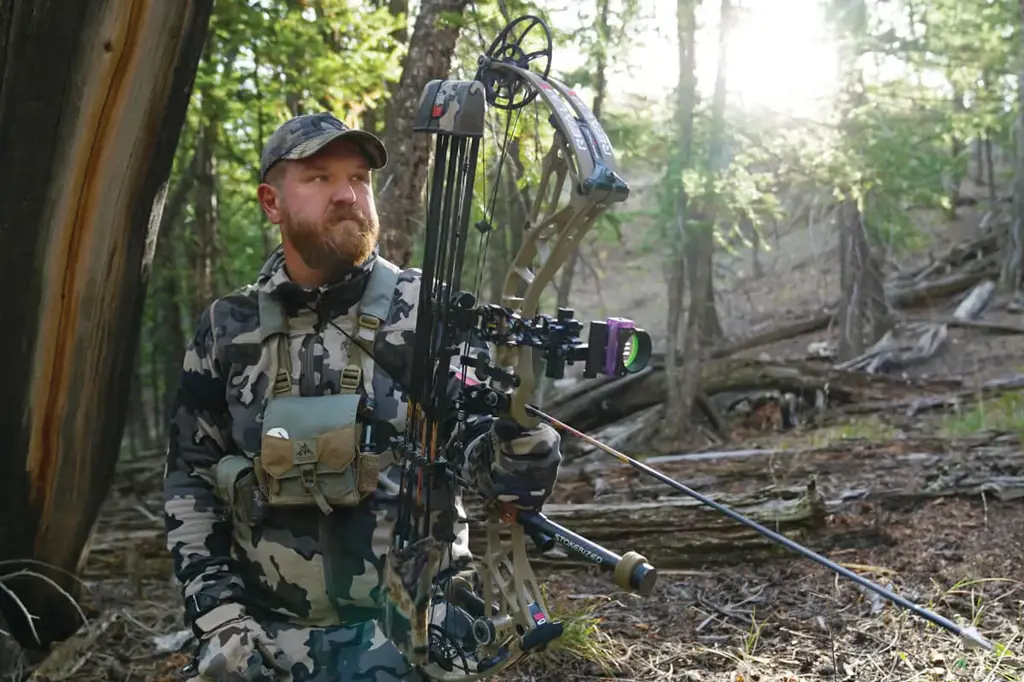
Backcountry hunting is a challenging and rewarding experience, but it requires a certain level of preparation and the right equipment. Whether you are a seasoned hunter or someone planning to embark on their first backcountry hunt, there are a few essential tools and equipment that you should consider bringing along to ensure a successful and safe trip.
First and foremost, a reliable and sturdy backpack is a must-have for any backcountry hunt. Look for a backpack that is specifically designed for hunting, with features like a large capacity, multiple compartments, and a comfortable harness system. This will allow you to carry all your gear, supplies, and possibly even game meat comfortably and efficiently.
In addition to a backpack, you will also need a good quality hunting knife. This versatile tool is essential for field dressing and skinning game animals. Look for a knife with a fixed blade and a comfortable grip to ensure precise and safe handling.
When it comes to navigation, a GPS device is highly recommended for backcountry hunting. This will help you stay on track and find your way in unfamiliar territory. Make sure to choose a GPS with a long battery life, topographic map capabilities, and the ability to mark waypoints.
Another important piece of equipment is a reliable and durable tent. This will serve as your shelter during your backcountry hunt, providing protection from the elements and a comfortable place to rest. Look for a tent that is lightweight, easy to set up, and designed for the specific weather conditions you anticipate encountering.
Alongside your tent, you will need a high-quality sleeping bag and sleeping pad. These items will help you stay warm and comfortable during the night, even in low temperatures. Opt for a sleeping bag that is rated for the expected temperature range and a sleeping pad that offers insulation and comfort.
Since backcountry hunting often requires extended periods away from civilization, it is important to bring enough food and water to sustain yourself. Consider lightweight and nutrient-dense options like freeze-dried meals and energy bars. It is also a good idea to invest in a water filtration system or purification tablets to ensure a clean and safe water source.
Additionally, a good pair of binoculars is a must-have tool for spotting game from a distance. Look for binoculars that have a high magnification power and clarity to help you identify game animals and assess their size and distance accurately.
Lastly, don't forget about safety equipment. This includes items like a first aid kit, a headlamp, a fire-starting kit, and bear spray (if you are hunting in bear country). These items will help you stay prepared for unexpected situations and ensure your overall safety throughout the hunt.
In conclusion, a backcountry hunt requires specific tools and equipment to ensure a successful and safe experience. These include a reliable backpack, a quality hunting knife, a GPS device, a tent, a sleeping bag and pad, food and water supplies, binoculars, and safety equipment. By investing in the right gear and being prepared, you can maximize your chances of a successful hunt and enjoy the breathtaking beauty of the backcountry.
Essential Items for a Mediterranean Cruise in May
You may want to see also

How should I pack and carry my gear for a backcountry hunt to ensure maximum comfort and efficiency?
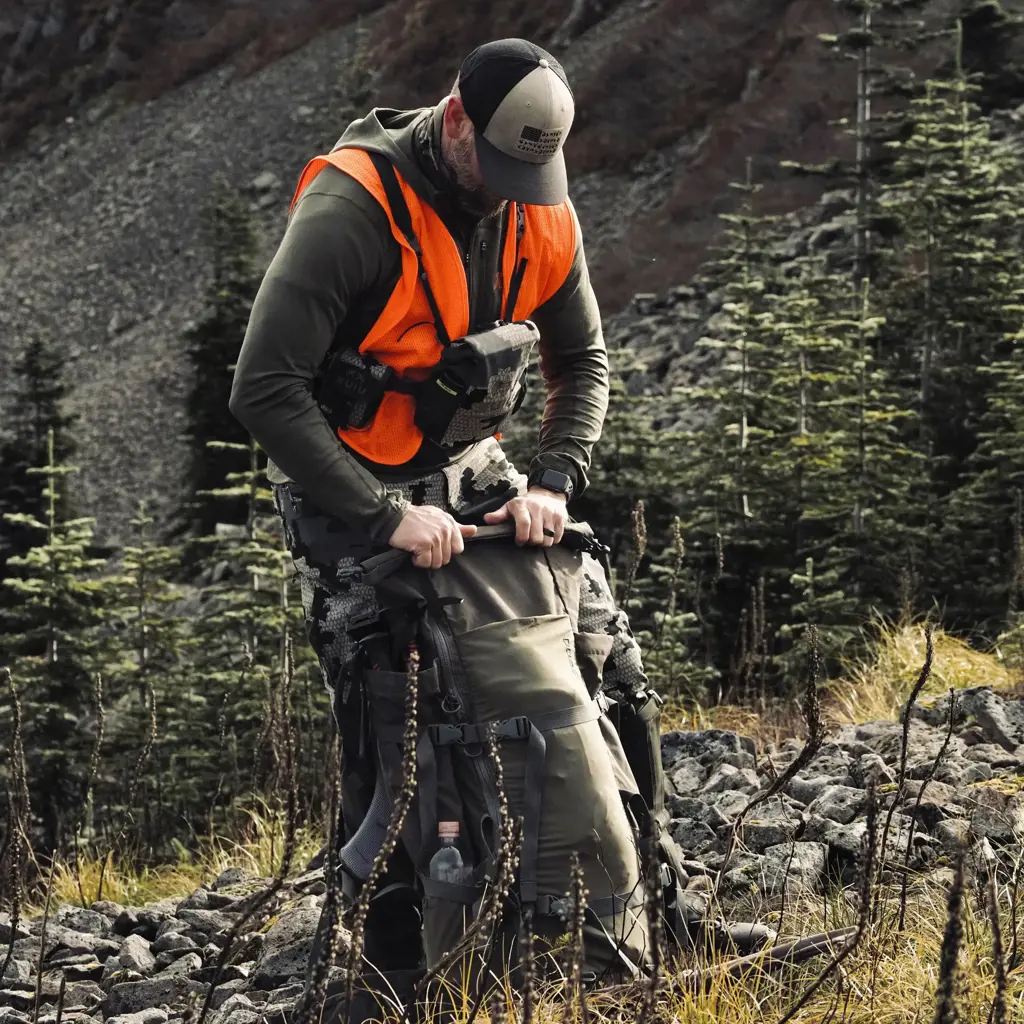
Going on a backcountry hunt requires careful planning and preparation to ensure maximum comfort and efficiency. One of the most crucial aspects of this preparation is packing and carrying your gear. Properly packing and organizing your gear can make a significant difference in your overall hunting experience. In this article, we will discuss how you should pack and carry your gear for a backcountry hunt to ensure maximum comfort and efficiency.
Create a gear checklist:
Before you start packing, it is important to create a gear checklist. This will help you keep track of all the essential items you need to take with you. Make sure to include items such as a tent, sleeping bag, cooking equipment, hunting gear, and clothing. By creating a checklist, you can ensure that you don't forget any essential items.
Choose the right backpack:
Invest in a good quality backpack that is designed specifically for backcountry hunting. Look for a backpack that has enough space to accommodate all your gear and is comfortable to wear for long periods. Consider the weight distribution and padding when selecting a backpack. A backpack with a frame and adjustable straps can help distribute the weight evenly, making it easier to carry.
Organize gear by priority:
When packing your gear, prioritize items based on their importance and accessibility. Items that you may need frequently, such as water, snacks, and a first aid kit, should be easily accessible. Place them in the outer pockets or the top compartment of your backpack. Less frequently used items, such as extra clothing or camping gear, can be packed in the main compartment.
Use compression sacks and packing cubes:
Compression sacks and packing cubes can help maximize the space in your backpack and keep your gear organized. Use compression sacks for bulky items like sleeping bags and clothing. These sacks will compress the items, reducing their size and creating more space in your bag. Packing cubes can be used to separate and organize smaller items, such as socks, underwear, and hunting accessories.
Distribute weight evenly:
When loading your gear into your backpack, distribute the weight as evenly as possible. Heavy items should be placed in the middle of your pack, close to your back. This will help maintain balance and stability while hiking. Lighter items can be placed towards the bottom or the top of the backpack.
Secure loose items:
Ensure that all loose items are secured to prevent them from shifting or falling out while hiking. Use straps or bungee cords to secure items such as trekking poles, a camping chair, or a rifle. This will prevent unnecessary noise and discomfort while on the move.
Test your gear setup before the hunt:
Before heading out on your backcountry hunt, it is important to test your gear setup. Load your backpack with all the necessary items and take it for a test hike. This will help you identify any discomfort or issues with weight distribution. Make adjustments as needed to ensure maximum comfort and efficiency.
In summary, proper packing and carrying of your gear are crucial for a successful backcountry hunt. By following the steps outlined above and organizing your gear efficiently, you can ensure maximum comfort and efficiency while enjoying your hunting experience. Remember to create a gear checklist, choose the right backpack, organize gear by priority, use compression sacks and packing cubes, distribute weight evenly, secure loose items, and test your gear setup before the hunt. Happy hunting!
The Essential Guide to Packing Shoes for Your Next Cruise
You may want to see also
Frequently asked questions
When it comes to clothing for a backcountry hunt, it's important to pack items that are versatile, durable, and suited for different weather conditions. Consider packing layers such as base layers, insulation layers, and outer shell layers. Opt for moisture-wicking and quick-drying materials to keep you comfortable during periods of activity. Don't forget to pack extra socks, gloves, and a hat to keep you warm in cold weather.
Yes, there are some special equipment items that you should consider packing for a backcountry hunt. These may include a backpack with a frame and a meat hauling system, a good quality sleeping bag and sleeping pad, a stove for cooking meals, a water filter or purification system, and a lightweight shelter such as a tent or tarp. It's also important to pack a good quality hunting knife, a headlamp or flashlight, and a reliable GPS or map and compass for navigation.
When it comes to food for a backcountry hunt, it's important to choose lightweight, high-calorie options that are easy to prepare and won't spoil easily. Consider packing dehydrated or freeze-dried meals that can be rehydrated with hot water, energy bars or gels, jerky, nuts, dried fruit, and instant oatmeal or rice. It's also important to pack enough water or a water purification system to ensure you stay hydrated throughout your hunt.
In addition to clothing, equipment, and food, there are a few other essential items that you should include in your backcountry hunting pack. This may include a first aid kit with basic medical supplies, fire-starting equipment such as matches or a lighter, insect repellent, sunscreen, a compact game bag for meat storage, and toiletries such as toilet paper and biodegradable soap. It's also a good idea to pack a small repair kit with items such as duct tape, zip ties, and extra paracord in case of gear malfunctions or emergencies.







